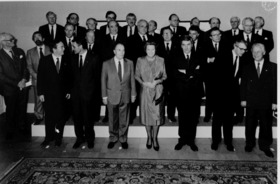Treaty of Maastricht

- Maastricht, Group Photo (Photo: European Commission)
Treaty of Maastricht
The Treaty of Maastricht paved the way for the further European integration, in particular by introducing the Economic and Monetary Union. It represents the biggest development of the treaties until the Lisbon Treaty. Signed in 1992, it came into force on 1 November 1993.
By modifying the previous treaties - Paris, Rome, and the Single European Act - a political "union" was proclaimed.
The EC changed its abbreviated name to the EU.
The new policy areas were divided into two new intergovernmental pillars in addition to the first supra-national community pillar.
The second pillar is the Common Foreign and Security Policy (CFSP), and the third pillar is Justice and Home Affairs (JHA).
Notes
The Treaty of Maastricht:
- Changed the official name of the EEC/EC to the "European Union".
- Introduced the Economic and Monetary Union, EMU.
- Established the Ombudsman and the Committee of the Regions.
- Introduced more qualified majority voting.
- Introduced the co-decision procedure.
- Increased the influence of the European Parliament through a, then new, co-decision procedure.
Links
http://europa.eu/scadplus/treaties/maastricht_en.htm
